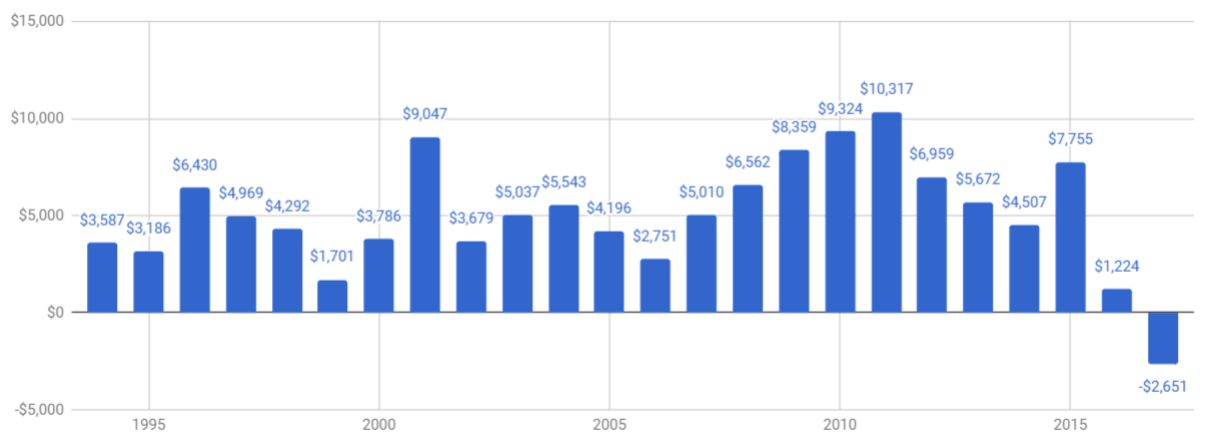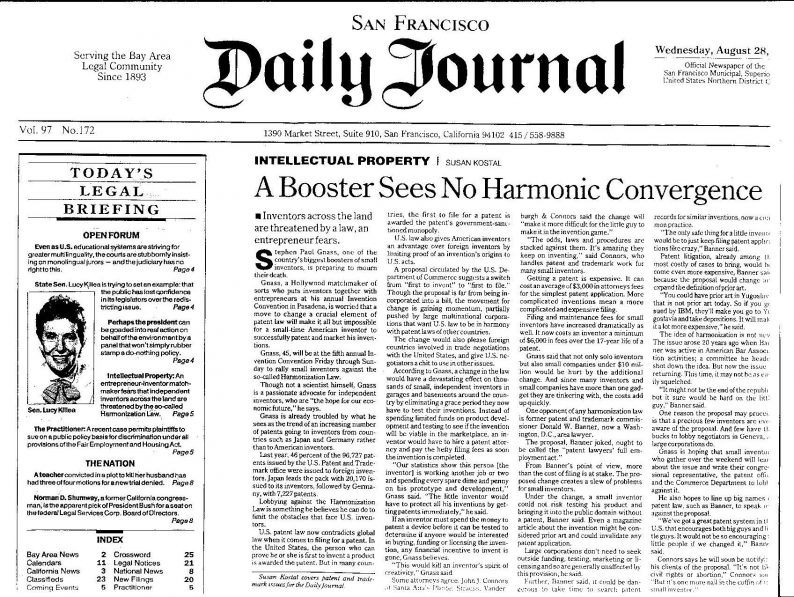“If you haven’t prepared, you won’t have the courage to seize it. When I bought all that stock that the Daily Journal has in, like, one day…I knew something about Bank of America. I’ve lived in the culture, I’ve known the Bank of America bankers, I know a lot about what’s right with it and what’s wrong with it. I knew a lot about Wells Fargo. I knew a lot about U.S. Bank.”
“I talked about patience. I have read Barron’s for fifty years. In fifty years I found one investment opportunity in Barron’s, out of which I made about $80 million with almost no risk. I took the $80 million and gave it to Li Lu, who turned it into $400 or $500 million. So, I have made $400 or $500 million from reading Barron’s for fifty years and finding one idea. Now, that doesn’t help you very much, does it? Well, I’m sorry, but that’s the way it really happened.”
– Charlie Munger, 2017
The Charlie Munger faithful were recently treated to another annual meeting of The Daily Journal Corporation, a company in which the billionaire is Chairman. Of course, Munger’s notoriety is mostly attributable to his role as Vice Chairman of Berkshire Hathaway. The Daily Journal Corporation has published legal newspapers for many years, relying primarily on public notice advertising for income. Public notice advertising is advertising that is required legally for certain notices to be placed in a newspaper approved by the courts. More recently, Munger has invested the Daily Journal’s excess cash in common stocks and corporate bonds – which is what has attracted it so much attention over the previous decade – and created a software company through acquisitions called Journal Technologies.
Since Munger is the Chairman of the company and the individual primarily in charge of capital allocation, it is no surprise that Daily Journal’s success has his fingerprints on it, although Gerald Salzman, who has run the day to day operations for many years, does not receive as much credit as he probably deserves. The Daily Journal specifically illustrates Munger’s oft-repeated admonition to ‘defer gratification’ throughout life and investing.
“It’s waiting that helps you as an investor, and a lot of people just can’t stand to wait. If you didn’t get the deferred-gratification gene, you’ve got to work very hard to overcome that.”
It is a peculiar comment to make to investors because the act of investing is an act of deferred gratification (unless someone is investing with debt). Saving and investing requires deferring consumption now in the hope that later, more consumption is possible. But, this principle of deferred gratification can also be applied with more nuance, and the manner in which Daily Journal has been run provides some terrific examples.
The Daily Journal’s purchases of marketable securities are a very good example of this practice in action, but the management of Journal Technologies also provides plenty of lessons for business owners and managers. Both are discussed at some length below.

A copy of the San Francisco Daily Journal, which is said to be based on the layout of The Wall Street Journal because of Munger’s admiration of the paper.
Some Background
One of Munger’s previous law partners was hired to oversee the sale of the Los Angeles Daily Journal in 1977, inciting a bid from Munger of $2.5 million, which he won. The purchase was made through the New America Fund. That fund was a closed-end fund that Munger had purchased in his previous investment partnership below its net asset value and moved its philosophy into value investing. J.P. Guerin was Munger’s partner at the New America Fund and when the fund liquidated in 1986, Daily Journal shares were distributed to owners of the fund, with a large share going to Munger and Guerin. Acquisitions over time brought additional legal publications into the fold.
Once attractive acquisitions in the publishing field became scarcer and it also became clear that the world was becoming less kind to print publishing, the company would often invest its excess cash in treasury bills and notes. By the end of 1998, the company’s cash and treasuries balance was $13 million, and $6.7 million of that balance was used to purchase 80% of a software company called Choice Information Systems, which was renamed Sustain Technologies. In its first year as part of The Daily Journal Corporation, it had revenues of $1.3 million. Following the acquisition, Munger once again began doing little with excess cash besides purchasing treasuries. Then, one of the best things to ever happen to The Daily Journal Corporation occurred: the global economy went into a severe financial crisis.
The financial crisis contributed to the good fortune of Daily Journal in two ways. First, it substantially increased the demand for foreclosure notices to be published in the company’s newspapers. Cash flow from operations was $2.8 million in 2006 but increased to $5.0 million in 2007, $6.6 million in 2008, and $8.4 million in 2009. By the end of 2008, the company’s cash and treasuries position had grown to $23 million, which could be put to work because of the second way the financial crisis benefited the company: extremely attractive investment opportunities had become available.

The Daily Journal’s cash and treasuries (in blue) and marketable securities (in red). The cash and securities totaled dropped after a software acquisition in 1999 but was then replenished until invested in marketable securities.

Operating cash flow by year for the Daily Journal Corporation. Despite general declines in the print industry, a flurry of foreclosure notices lifted results during and immediately after the financial crisis.
Marketable Securities













Leave A Comment